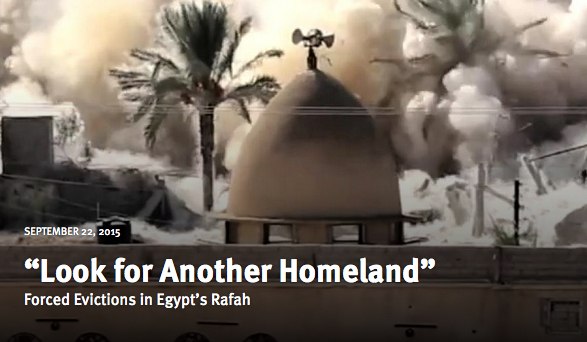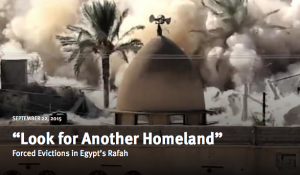

In the report “Look for another homeland” the international Human Rights organisation Human Rights Watch focus on the illegal evictions of the inhabitats of Rafah in Egypt.
“Between July 2013 and August 2015, Egyptian authorities demolished at least 3,255 residential, commercial, administrative, and community buildings in the Sinai Peninsula along the border with the Gaza Strip, forcibly evicting thousands of people. Extended families who had lived side by side for decades found themselves dispersed, forced to abandon the multi-story houses they had built next to their relatives and passed down through generations. Some families became homeless and lived in tents or sheds on open land or in informal settlements. The Egyptian authorities razed around 685 hectares of cultivated farmland, depriving families of food and livelihood and stripping most of the border of its traditional olive, date and citrus groves. The evictions scattered families among the Sinai’s towns and villages and in some cases as far as Cairo and the Nile Delta. The Egyptian government has indicated that these evictions could continue.
The Egyptian army began demolishing buildings along the border in July 2013 as part of a reinvigorated but long-considered plan to establish a “buffer zone†with the Gaza Strip. These demolitions rapidly accelerated after October 24, 2014, when the Sinai-based armed group Ansar Beit al-Maqdis, or Supporters of Jerusalem, carried out an unprecedented attack on an army checkpoint in North Sinai governorate, reportedly killing 28 soldiers. The following month, Ansar Beit al-Maqdis pledged allegiance to the extremist group Islamic State, also known as ISIS, and changed its name to Sinai Province.
President Abdel Fattah al-Sisi, who had taken office in June 2014 after orchestrating the ouster of former
Egyptian officials described the buffer zone as a way to clear the border area for military operations and eliminate this supply line. A statement on the Defense Ministry’s website described the zone as a way to “finally eliminate the problem†of tunnels, “one of the main sources†for armed groups to enter Sinai and supply insurgents with “arms and ammunition.†Maj. Gen. Abd al-Fattah Harhour, the governor of North Sinai, said the decree was intended “to defend Egypt from terrorism.†One advisor to the military’s Commanders and Staff College told a newspaper that the buffer zone would have two benefits: putting the zone under military court jurisdiction and clearing it of civilians, so that it would “be regarded as an open theater.â€president Mohamed Morsy the year before, said in a speech on national television the day after the attack that Egypt was fighting a war “for its existence.†He declared a three-month state of emergency in most of North Sinai and convened the National Defense Council and Supreme Council of the Armed Forces, which agreed on a plan to establish a “secure zone†along the Gaza border. Five days after the attack, Prime Minister Ibrahim Mehleb issued a decree ordering the “isolation†and “evacuation†of 79 square kilometers stretching along the entire Gaza border and extending between five and seven kilometers into the Sinai. The buffer zone encompassed all of Rafah, a town of some 78,000 people that lies directly on the border, as well as significant agricultural land around the town.
Egyptian authorities justified the buffer zone as a way to defeat the insurgency by shutting down the smuggling tunnels that they said allowed fighters and weapons to pass from Gaza to the Sinai. Since 2007, Gaza, which is governed by the Islamist Palestinian movement Hamas, has been under a strict Israeli blockade. For most of this period, Egypt has cooperated in the blockade by severely restricting the flow of people and goods between Gaza and the Sinai. Tunnels have served as a key supply line between the two sides.”
